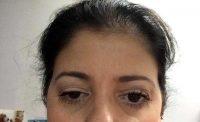Botox Side Effects – Droopy Eyelid
Injecting too much Botox in the forehead can make the eyebrows and upper eyelids appear heavy. The idea is not to be frozen, the goal is to soften your expression lines. (Ava Shamban, MD, Santa Monica Dermatologic Surgeon)
Heavy eyelids after Botox
It is not unusual to report the sensation of heavy eyelids after Botox treatment. Also, ptosis , which is drooping of the eyelids, can occur after Botox injection. The incidence has been reported in various source anywhere from 3-4 % of injections.
I my experience, we see it much much lower but do see it on occasion. It does not necessarily imply that you received too much Botox as it may be related to placement or diffusion of the Botox.

Botox Causing Eyebrow Droop
The good news is that it is not a serious side effect and resolves 100% of the time, typically within 2 weeks of the occurrence. (Steven Hacker, MD, West Palm Beach Dermatologic Surgeon)
Botox can result in eyebrows dropping
You may be experiencing:
- eyelid ptosis – Botox drifted into the muscle that elevates the eyelid – this can result in the one eyelid looking baggy, and one eye being hard to open all the way. This is a very uncommon side effect, but it is devastating when it happens. It will wear away, but can take several weeks.
- eyebrow ptosis – If only your 11’s were injected, Botox also affected the the forehead muscle and weakened the forehead. Your eyebrow position is a balance between your forehead muscle and your brow depressors. This usually results in a symmetric drop of both brows and the inability to lift your eyebrows very well. This is a more common side effect than eyelid ptosis, and it too will wear away. (Melissa Chiang, MD, FAAD, Houston Dermatologic Surgeon)

Botox May Have Leaked Out To A Muscle That Raises And Lowers The Upper Eyelid Called The Levator
Botox injected in the central forehead above the pupils can result in a lack of elevation function of the brow and the resulting heavy eyelids. The result can last several months. To avoid this occurrance , botox is best kept in the central forehead and lateral brow and crowsfeet. (Lee Kleiman, MD, Annapolis Facial Plastic Surgeon)
Too Much Botox Cause Eyebrows to Drop
There are 2 reasons why eyelids droop after Botox.
- Botox is injected close to the eye socket. The Botox diffuses into the eye socket and paralyses the Levator muscle that is responsible for opening the upper eyelid.
- As you get older, your levator muscle of the upper eyelid gradually becomes weak. This causes the eyelids to droop a little. The brain sends impulses to the forehead muscle to act. The forehead muscle lifts the eyebrow and indirectly lifts the eyelid, therefore helping the levator muscle of the eyelid.

Can Botox Cause Eyebrow Droop
An experienced doctor will notice this on assessment of the patient. If the Doctor fails to notice this and proceeds with injecting the forehead muscle with Botox, the forehead muscle will become weak and unable to lift the eyebrow and the eyelid.
This is noticed by the patient as a droopy eyelid. (Naveen Somia, MBBS, PhD, FRACS, Sydney Plastic Surgeon)
Eyebrow drop after Botox
Botox can cause heaviness of the brows and upper eyelid areas depending on the patient and injection technique. In a patient with heavy brows or brows that are being constantly held up by the forehead muscles, weakening the forehead muscles with Botox can cause the brows to come down and affect the upper eyelid area.
This can often be counteracted by light treatment of the forehead and simultaneous treatment of the glabella and crow’s feet areas, as these muscle cause depression of the brow. Botox can also cause drooping of the eyelid known as ptosis, but this is a different issue altogether and is treated differently.

Eyebrow Droop From Botox
Always see an expert physician injector. (Matthew Richardson, MD, Frisco Facial Plastic Surgeon)
Botox & Eyebrows Dropping
It’s not unusual for patients to request treatment of transverse forehead wrinkles. These wrinkles are caused by contraction of the frontalis muscle, which is an elevator of the brow. Unfortunately efforts to relax this muscle and diminish wrinkles can be accompanied by a lowered brow position.
In some cases migration of botox can also result in paralysis of the upper eyelid muscles as well. This characteristically causes a unilateral eyelid droop. These problems can be caused by both excessive botox and migration of botox.
Both the eyelid and eyebrow can be affected. In most cases this resolves in 2 to 3 months following injection without treatment. In some cases when the eyelid is severely impacted special eye drops can be utilized to treat the problem.
When this situation arises it’s important to stay in close contact with your provider. In some cases the best approach is tincture of time, while in other cases a more aggressive approach may be necessary.
In these situations specialized eye drops might help eyelid sag until it can improve on its own. (Richard J. Bruneteau, MD, Omaha Plastic Surgeon)
Botox relaxes muscles
Botox relaxes the muscles it is injected into. If you injector placed it in the muscles that elevate your lateral brow, you will lose the ability to raise your lateral brow. This may manifest as droop, as some people unconsciencly keep their lateral brow elevated at all waking hours.(Stephan Finical, MD, Charlotte Plastic Surgeon)
Too Much Botox can Cause Eyebrows to Droop

My Eyelids Are Looking Droopy
The frontalis muscle is the muscle in the forehead that holds or pulls the eyebrows up. To much botox in the forehead can definitely over treat this muscle and the brow can droop down, which may result in the appearance of excess skin in the upper eyelid area.
This is especially true in some patients that tend to have low brows and who rely on their frontalis muscle to hold their brows upward. The amount of botox can be too much or it may have been placed too low.
Additionally, if placed too low, some can theroetically affect the levator muscle or the muscle that holds your upper eyelid up and this can result in a droopy eyelid. If you have trust in this physician, I would recommend that you let her know and have a followup examination to determine the issue.
Please be wary of going to centers that charge apparently very low prices or to those that are not trained in Botox as a well trained physician will try to avoid these issues. (Ghada Y. Afifi, MD, FACS, Orange County Plastic Surgeon)
The droopiness will go away as the Botox wears off
The droopiness of your brow line resulting in more bagginess in your eyelid fold is most likely from either the placement of the injections or the amount of Botox units used. Rest assured that the droopiness you are experiencing from the Botox is temporary and it will wear off.
Be sure and discuss the results of your treatment with your provider so that they can make some changes to your treatment “recipe” next time. Also, please look for a board certified plastic surgeon who specializes in aesthetics.
You can find a list of physicians in your area who are members of The American Society for Aesthetic Plastic Surgery. (Dan Mills, MD, Orange County Plastic Surgeon)
Droopy eyelid
There are 2 ways to have this problem from Botox injections. If the product is placed too low on the forehead, the muscle that raises the forehead (frontalis) will be inactivated and not able to lift the brow.

How Long Does Botox Eyebrow Droop Last
A droopy brow can look like a droopy lid , but usually will correct if you pull the lateral brow upward with your finger. If it corrects by you doing this, a little Botox placed by an experienced injector into the lateral tail of the brow, into the eye muscle (orbicularis) may help relieve the downard pull somewhat.
If the lid stays drooped when you pull on the forehead, then the problem is that the Botox has reached the eyelid muscle (Muller’s) and this will only respond to eye drops, but only temporarily and drops need to be used frequently throughout the day.
Usually, this lid ptosis resolves quicker than the 3-4months you may have read about, somewhere in the 1-2 months range or shorter. The best treatment for these complications is prevention. I recommend that you seek a board certified dermatologist or facial plastic surgeon or plastic surgeon when getting any cosmetic procedures performed.
And please have the doctor do the injection themselves!. (Shawn Allen, MD, Boulder Dermatologist)
